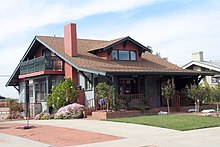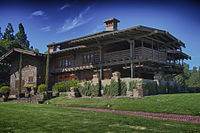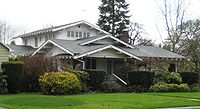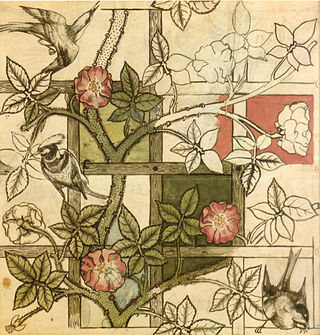
The Arts and Crafts movement was an international trend in the decorative and fine arts that developed earliest and most fully in the British Isles and subsequently spread across the British Empire and to the rest of Europe and America.

A bungalow is a small house or cottage that is single-story, and may be surrounded by wide verandas.
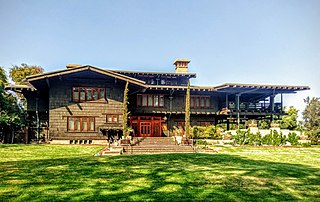
The Gamble House, also known as the David B. Gamble House, is an iconic American Craftsman home in Pasadena, California, designed by the architectural firm Greene and Greene. Constructed in 1908–1909 as a home for David B. Gamble, son of the Procter & Gamble founder James Gamble, it is today a National Historic Landmark, a California Historical Landmark, and open to the public for tours and events.

Gustav Stickley was an American furniture manufacturer, design leader, publisher, and a leading voice in the American Arts and Crafts movement. Stickley's design philosophy was a major influence on American Craftsman architecture.

California bungalow is an alternative name for the American Craftsman style of residential architecture, when it was applied to small-to-medium-sized homes rather than the large "ultimate bungalow" houses of designers like Greene and Greene. California bungalows became popular in suburban neighborhoods across the United States, and to varying extents elsewhere, from around 1910 to 1939.

Greene and Greene was an architectural firm established by brothers Charles Sumner Greene (1868–1957) and Henry Mather Greene, influential early 20th Century American architects. Active primarily in California, their houses and larger-scale ultimate bungalows are prime exemplars of the American Arts and Crafts Movement.

An ultimate bungalow is a large and detailed American Craftsman-style home, based on the bungalow form.
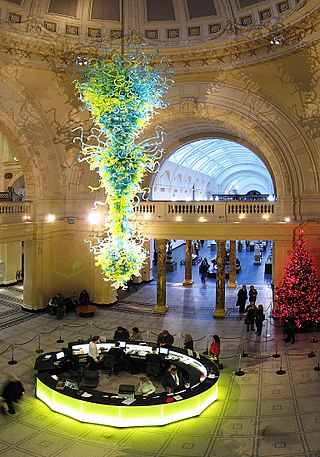
American craft is craft work produced by independent studio artists working with traditional craft materials and processes. Examples include wood, glass, clay (ceramics), textiles, and metal (metalworking). Studio craft works tend to either serve or allude to a functional or utilitarian purpose, although they are just as often handled and exhibited in ways similar to visual art objects.

Craftsman Farms is a historic house located in Parsippany-Troy Hills, Morris County, New Jersey, United States. It was founded by noted early 20th century designer Gustav Stickley as a farm and school for the Arts and Crafts movement. It remained in use until 1915 when it was sold to a family and became a private house.

The William R. Thorsen House, often referred to as the Thorsen House, is a historic residence in Berkeley, California. Built in 1909 for William and Caroline Thorsen, it is one of the last of four standing ultimate bungalows designed by Henry and Charles Greene of the renowned architectural firm Greene & Greene and the only one located in Northern California.

The Thomas Gould Jr. House is a historic house located at 402 Lynn Drive in Ventura, California. Architect Henry Mather Greene designed the American Craftsman style California bungalow, which was built in 1924. The house is considered one of the best examples of Henry Greene's independent work; most of his other designs were created alongside his brother Charles as Greene & Greene. The two-story house has a wood frame and redwood siding and window casings. The gable roof features truncated ends and a small gable on the front side which resembles a dormer. The house's interior decorations include ceiling moldings, a leaded glass china cabinet, and a carved mirror, the latter being the only piece of furniture designed by Greene himself.
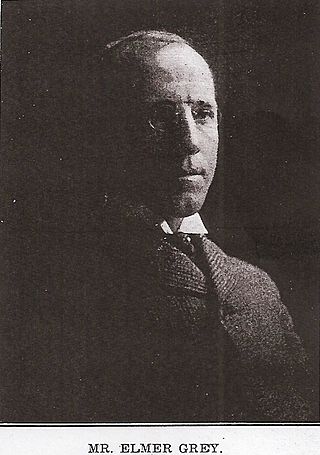
Elmer Grey, FAIA was an American architect and artist based in Pasadena, California. Grey designed many noted landmarks in Southern California, including the Beverly Hills Hotel, the Huntington Art Gallery, the Pasadena Playhouse and Wattles Mansion. He is credited with being one of the pioneers in the development of the new American architecture in the early 20th century, with a focus on harmony with nature and eliminating features not belonging to the local climate and conditions. Grey was also a noted artist whose paintings are in the permanent collection of the Chicago Art Institute.

Harvey Ellis was an American architect, perspective renderer, painter and furniture designer. He worked in Rochester, New York; Utica, New York; St. Paul, Minnesota; Minneapolis, Minnesota; St. Joseph, Missouri; St. Louis, Missouri and Syracuse, New York.

Mission furniture is a style of furniture that originated in the late 19th century. It traces its origins to a chair made by A.J. Forbes around 1894 for San Francisco's Swedenborgian Church. The term mission furniture was first popularized by Joseph P. McHugh of New York, a furniture manufacturer and retailer who copied these chairs and offered a line of stylistically related furnishings by 1898. The word mission references the Spanish missions throughout colonial California, though the design of most Mission Style furniture owed little to the original furnishings of these missions. The style became increasingly popular following the 1901 Pan-American Exposition in Buffalo. The style was popularly associated with the American Arts and Crafts movement.

The Craftsman was a magazine founded by the American furniture designer Gustav Stickley that championed the American Arts and Crafts movement.
In the United States, the National Register of Historic Places classifies its listings by various types of architecture. Listed properties often are given one or more of 40 standard architectural style classifications that appear in the National Register Information System (NRIS) database. Other properties are given a custom architectural description with "vernacular" or other qualifiers, and others have no style classification. Many National Register-listed properties do not fit into the several categories listed here, or they fit into more specialized subcategories.

Furniture created in the Art Nouveau style was prominent from the beginning of the 1890s to the beginning of the First World War in 1914. It characteristically used forms based on nature, such as vines, flowers and water lilies, and featured curving and undulating lines, sometimes known as the whiplash line, both in the form and the decoration. Other common characteristics were asymmetry and polychromy, achieved by inlaying different colored woods.
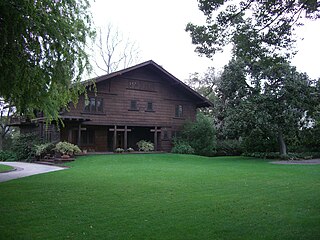
The Spinks House, also known as Margaret B. S. Clapham Spinks House, is a restored example of a California bungalow in Pasadena, California, USA. The house and grounds were designed by Henry Mather Greene of the architectural firm Greene and Greene as a home for Margaret B. S. Clapham Spinks and the retired judge William Ward Spinks.
Ernest George Washington Dietrich, AIA was an American architect. Born and raised in Pittsburgh, Pennsylvania, Dietrich relocated to New York City in 1886 where he would practice for nearly forty years. His work included the design of churches, libraries, hotels, commercial and public buildings, but he is most highly regarded for his residential designs in the shingle, colonial revival, and arts and crafts styles. In cooperation with furniture designer Gustav Stickley, Dietrich designed the first "Craftsman House" published in The Craftsman magazine in May 1903.
